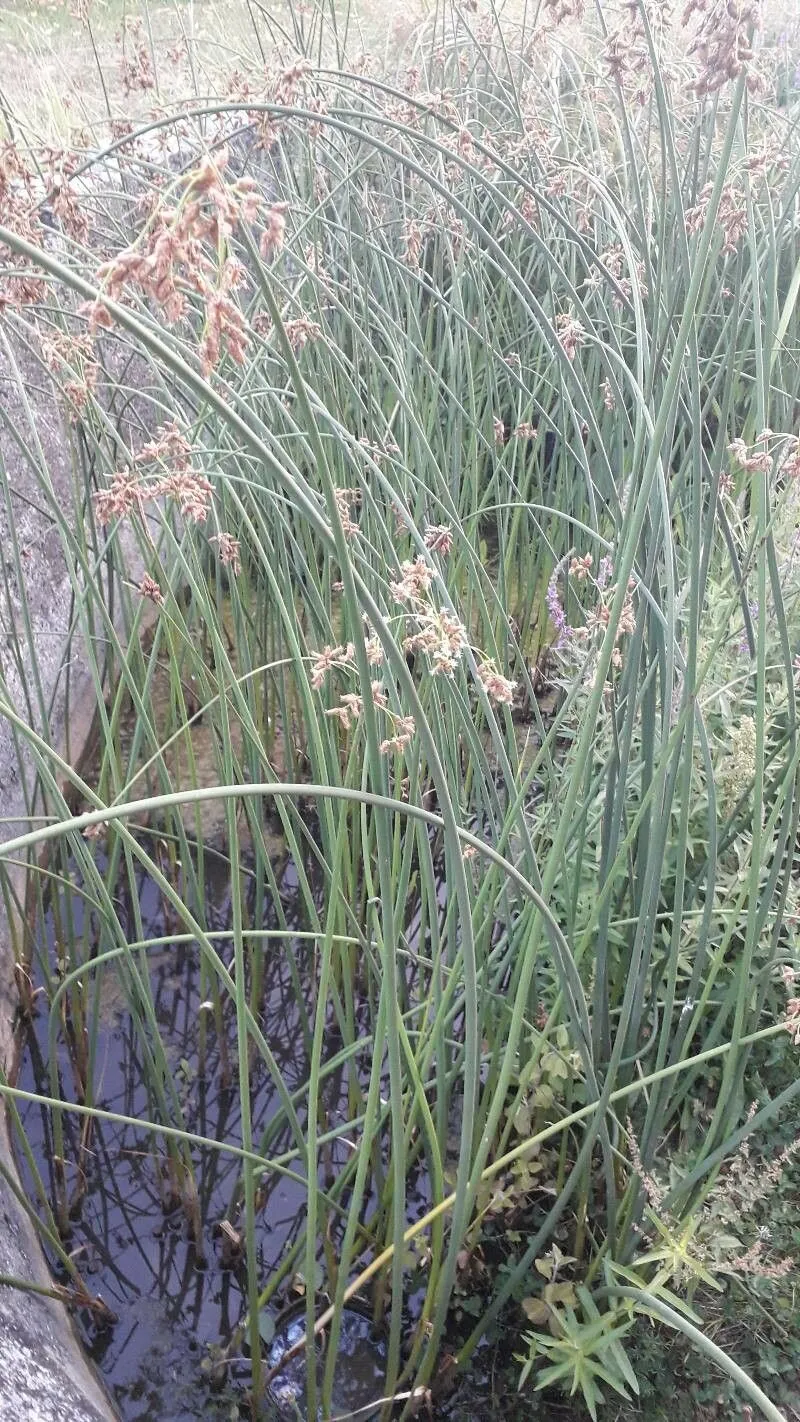
Author: (L.) Palla
Bibliography: Bot. Jahrb. Syst. 10: 299 (1888)
Year: 1888
Status: accepted
Rank: species
Genus: Schoenoplectus
Vegetable: False
Observations: Europe, Medit. to Mongolia, S. Africa
The Common club-rush, known scientifically as Schoenoplectus lacustris, is a perennial aquatic plant extensively observed in a variety of regions including Europe, the Mediterranean to Mongolia, and southern Africa. Originally detailed in the botanical literature in 1888 by the renowned botanist Palla, Schoenoplectus lacustris belongs to the Cyperaceae family, noted for its significant environmental versatility and robust nature.
Typically inhabiting wetlands, marshes, and the edges of freshwater bodies, the Common club-rush plays a vital ecological role in its native habitats. Its strong, upright stems can reach impressive heights, providing essential habitat and protection for a plethora of wildlife species, from insects to birds. Additionally, the dense stands of this plant are incredibly effective at stabilizing soil and preventing erosion, making it an invaluable component of wetland ecosystems.
The structure of Schoenoplectus lacustris is characterized by its tall, cylindrical stems which are both tough and flexible, allowing the plant to thrive in water-saturated soils. The leaves of this species are reduced to sheaths, adapting the plant perfectly to its aquatic environment. When in bloom, it produces clustered inflorescences which give rise to small, inconspicuous flowers, further contributing to its reputation as an understated yet ecologically important species.
Given its wide distribution across diverse climate zones, the Common club-rush not only highlights the adaptability and resilience of the Cyperaceae family but also underscores the intricate dependencies within ecosystems where it is found. The historical and botanical significance of this plant, brought to light in Palla’s 1888 publication in “Botanische Jahrbücher für Systematik,” remains a cornerstone reference for botanists and ecologists studying wetland flora.
In conclusion, Schoenoplectus lacustris, or the Common club-rush, continues to be a subject of interest due to its widespread occurrence and ecological importance. Its presence in various regions around the world underscores both its adaptive evolution and the critical role it plays in maintaining healthy aquatic and wetland environments.
Deu: gewöhnliche teichsimse
Eng: lakeshore bulrush, common club-rush
Dan: sø-kogleaks, sø-kogleaks (submers form)
Nor: busæv, loppe-sæv, salsæv, sjøsæv, taksæv
Nld: mattenbies
Fra: scirpe des lacs, jonc des chaisiers commun, jonc des chaisiers
Swe: säv, kolvass, sjösäv
Sme: suotnjorávra, beatnatrávra
Ita: lisca lacustre
Cym: llafrwyn, llafrwynen, tostfrwynen
En: Common club-rush, Lakeshore bulrush, Great club-rush, Common Bulrush
Am: ሙሽ
Ar: جولان بحيري
Be: Чарот азёрны
Ca: Jonca d’estany
Zh: 沼生水葱
Cs: Skřípinec jezerní
Da: Sø-Kogleaks, Sø-kogleaks (submers form)
Nl: Mattenbies
Et: Järvekõrkjas, Järvkaisel
Fi: Järvikaisla
Fr: Scirpe des lacs, Jonc des chaisiers commun, Jonc des Chaisiers, Scirpe des lacs, jonc des chaisiers commun, Jonc-des-chaisiers, Jonc-des-tonneliers, Scirpe des étangs, Souchet des lacs
Gl: Buño
De: Gewöhnliche Teichbinse, Gewöhnliche Teichsimse, See-Flechtbinse, See-Simse, Seesimse, Teich-Simse, Gemeine Teichsimse, Gemeines Seeried, Grüne Seebinse
He: אגמון האגם
It: Biodo, Giunco da stuoje, Giunco, Lisca lacustre, Pavera, Giunco lacustre
Lt: Ežerinis meldas
Se: Suotnjorávra, Beatnatrávra
No: Sjøsivaks, Busæv, Loppe-sæv, Salsæv, Sjøsæv, Taksæv
Pl: Oczeret jeziorny
Pt: Bunho
Ru: Камыш озёрный
Sv: Säv, Kolvass, Sjösäv
Cy: Llafrwynen, Llafrwyn, Tostfrwynen
© copyright of the Board of Trustees of the Royal Botanic Gardens, Kew.
© copyright of the Board of Trustees of the Royal Botanic Gardens, Kew.
© copyright of the Board of Trustees of the Royal Botanic Gardens, Kew.
Taken Aug 28, 2020 by Matyas Szili (cc-by-sa)
Taken Jul 8, 2022 by michael ledeboer (cc-by-sa)
Taken Dec 16, 2021 by sajid manzoor (cc-by-sa)
Taken Jun 8, 2022 by Kuznetsova Arina (cc-by-sa)
Taken Aug 13, 2022 by Kate Senatskaya (cc-by-sa)
Taken Jul 29, 2018 by Annemarie Ahrens-Stehle (cc-by-sa)
Taken Jul 29, 2018 by Annemarie Ahrens-Stehle (cc-by-sa)
Taken Feb 26, 2022 by Beate Liebold (cc-by-sa)
Taken Aug 10, 2021 by Elisabeth Longchamp Schneider (cc-by-sa)
Taken Apr 1, 2022 by FUENTES LUIS (cc-by-sa)
Taken Jul 24, 2019 by Patrick Nard (cc-by-sa)
Taken May 27, 2007 by Tela Botanica − Daniel MATHIEU (cc-by-sa)
Taken Jul 25, 2011 by Tela Botanica − Bertrand BUI (cc-by-sa)
Taken Jul 23, 2022 by Richard Heimhilcher (cc-by-sa)
Taken Jan 30, 2022 by Julie – Anne (cc-by-sa)
Taken Jul 2, 2022 by Eric Favre (cc-by-sa)
Taken Jun 8, 2022 by Kuznetsova Arina (cc-by-sa)
Taken Aug 13, 2022 by Kate Senatskaya (cc-by-sa)
Taken Aug 13, 2022 by Kate Senatskaya (cc-by-sa)
Taken Aug 13, 2022 by Kate Senatskaya (cc-by-sa)
Taken Jul 25, 2019 by Meister Martin (cc-by-sa)
Taken Jun 26, 2021 by Pascal Huguenin (cc-by-sa)
Taken Jul 1, 2020 by Davk (cc-by-sa)
Taken Jul 4, 2018 by Tela Botanica − Jean-Claude Bouzat (cc-by-sa)
Taken May 30, 2022 by Jacques Zuber (cc-by-sa)
Taken Jun 23, 2022 by Fernández de Arcaya Teresa (cc-by-sa)
Taken Jan 1, 1970 by Photoflora – L’Abbé COSTE (©)
Taken Jul 15, 2009 by Photoflora – Benoit BOCK (©)
Taken Jun 30, 1854 by Tela Botanica − Herbier PONTARLIER-MARICHAL (cc-by-sa)
Taken Jan 1, 1800 by Tela Botanica − Daniel MATHIEU (cc-by-sa)
Growth habit: Graminoid
Ph maximum: 7.0
Ph minimum: 6.5
Light: 8
Atmospheric humidity: 9
Soil nutriments: 5
Soil salinity: 1
Family: Myrtaceae Author: (F.Muell.) K.D.Hill & L.A.S.Johnson Bibliography: Telopea 6: 402 (1995) Year: 1995 Status:…
Family: Rubiaceae Author: Pierre ex A.Froehner Bibliography: Notizbl. Bot. Gart. Berlin-Dahlem 1: 237 (1897) Year:…
Family: Sapindaceae Author: Koidz. Bibliography: J. Coll. Sci. Imp. Univ. Tokyo 32(1): 38 (1911) Year:…
Family: Asteraceae Author: A.Gray Bibliography: Pacif. Railr. Rep.: 107 (1857) Year: 1857 Status: accepted Rank:…
Family: Fabaceae Author: Medik. Bibliography: Vorles. Churpfälz. Phys.-Ökon. Ges. 2: 398 (1787) Year: 1787 Status:…
Family: Aspleniaceae Author: (Cav.) Alston Bibliography: Bull. Misc. Inform. Kew 1932: 309 (1932) Year: 1932…